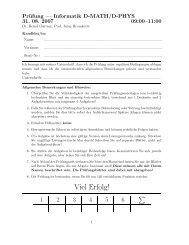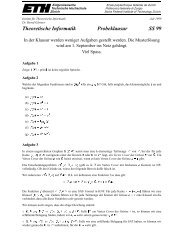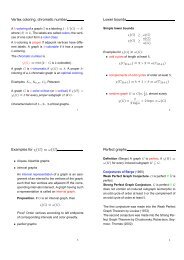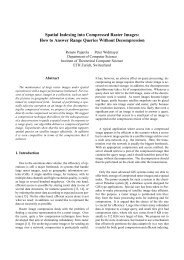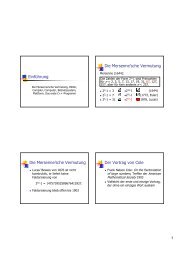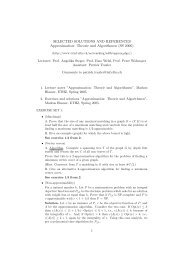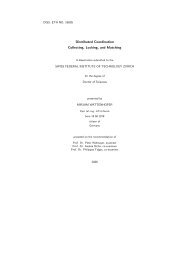Chapter 4 Line Sweep - TI
Chapter 4 Line Sweep - TI
Chapter 4 Line Sweep - TI
You also want an ePaper? Increase the reach of your titles
YUMPU automatically turns print PDFs into web optimized ePapers that Google loves.
<strong>Chapter</strong> 4. <strong>Line</strong> <strong>Sweep</strong> CG 2012<br />
Therefore the coordinate range in which this predicate can be evaluated exactly using<br />
IEEE double precision numbers shrinks down to integers between 0 and about 2 10 =<br />
1 024.<br />
Exercise 4.16 What is the algebraic degree of the predicate checking whether two line<br />
segments intersect? (Above we were interested in the actual intersection point,<br />
but now we consider the predicate that merely answers the question whether two<br />
segments intersect or not by yes or no).<br />
Exercise 4.17 What is the algebraic degree of the InCircle predicate? More precisely,<br />
you are given three points p,q,r in the plane that define a circle C and a fourth<br />
point s. You want to know if s is inside C or not. What is the degree of the<br />
polynomial(s) you need to evaluate to answer this question?<br />
4.5 Red-Blue Intersections<br />
Although the Bentley-Ottmann sweep appears to be rather simple, its implementation<br />
is not straightforward. For once, the original formulation did not take care of possible<br />
degeneracies—as we did in the preceding section. But also the algebraic degree of the<br />
predicates used is comparatively high. In particular, comparing two points of intersection<br />
lexicographically is a predicate of degree five, that is, in order to compute it, we need to<br />
evaluate a polynomial of degree five. When evaluating such a predicate with plain floating<br />
point arithmetic, one easily gets incorrect results due to limited precision roundoff errors.<br />
Such failures frequently render the whole computation useless. The line sweep algorithm<br />
is problematic in this respect, as a failure to detect one single point of intersection often<br />
implies that no other intersection of the involved segments to the right is found.<br />
In general, predicates of degree four are needed to construct the arrangement of line<br />
segments because one needs to determine the orientation of a triangle formed by three<br />
segments. This is basically an orientation test where two points are segment endpoints<br />
and the third point is an intersection point of segments. Given that the coordinates of<br />
the latter are fractions, whose numerator is a degree three polynomial and the common<br />
denominator is a degree two polynomial, we obtain a degree four polynomial overall.<br />
Motivated by the Map overlay application we consider here a restricted case. In the<br />
red-blue intersection problem, the input consists of two sets R (red) and B (blue) of<br />
segments such that the segments in each set are interior-disjoint, that is, for any pair of<br />
distinct segments their relative interior is disjoint. In this case there are no triangles of<br />
intersecting segments, and it turns out that predicates of degree two suffice to construct<br />
the arrangement. This is optimal because already the intersection test for two segments<br />
is a predicate of degree two.<br />
Predicates of degree two. Restricting to degree two predicates has certain consequences.<br />
While it is possible to determine the position of a segment endpoint relative to a(nother)<br />
38



